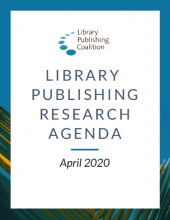
May 4, 2021
Intersections: Not Quite a Librarian, Not Quite a Publisher: What It’s Like to Work for a Library and a University Press
By Nancy Adams
Intersections is an occasional series where community members reflect on what they are seeing in other parts of their professional world and what library publishers can learn from it.
By Annie Johnson, Assistant Director of Open Publishing Initiatives and Scholarly Communications, Temple University @anniekjohn
For the past five years, I have worked for both Temple University Libraries and Temple University Press. Library colleagues at other institutions tend to assume I work for the Press. Press colleagues tend to assume I work for the Libraries. The truth is a bit more nuanced: much of my work involves leading what might be considered typical scholarly communication initiatives within the Libraries. However, my supervisor is the Director of the Press, Mary Rose Muccie, and I support the Press in important ways, particularly when it comes to open access and born-digital projects. That work has involved publishing the Press’s first digital companion to a print book, serving as the primary investigator for an NEH grant to digitize and make openly available out-of-print Press books in labor studies, and launching Temple’s instance of the digital publishing platform Manifold, which the Press now uses as a portal for its open access books. Most recently, we started a joint Libraries/Press imprint, North Broad Press, that publishes open textbooks written by Temple faculty.
Temple University Press is one of a number of presses that reports to its library. This is an increasingly common situation, which has resulted in the creation of positions like mine that try to bridge the two organizations. Despite its prevalence, some in scholarly publishing still worry about presses reporting to libraries, and question whether such a relationship actually benefits university presses. I understand the concerns, especially when these changes happen during moments when the larger university is in crisis. But I was not hired to dismantle or replace the work of the Press. Quite the opposite: I help the Press experiment with new publishing models in ways that they would simply not have the capacity to do otherwise. My involvement does not take away from the excellent work the Press staff are doing, it enhances it. I help get Temple University Press books out to more people around the globe while strengthening the Press’s relationship with the larger university. (more…)



